Announcement: My online Land Navigation course includes four hours of video instruction, and two downloadable PDF books, all for about the same price as a typical paperback book. Get my Land Navigation course here.
Direction Finding
by the Sun
Using the sun for direction finding is fairly easy to do once you understand how the sun works. An explanation of the sun's workings is available to you starting on my Celestial Navigation page.
Assuming you understand all the stuff explained there, let's get going on how you find directions by the sun.
Estimate the Direction of Sunrise and Sunset
To find your way, it's often helpful to know the direction in degrees of sunrise and sunset. To find these directions, you'll need to know the sun's maximum amplitude at your latitude. This is one fact you'll just have to remember. Most of your solar direction finding depends on this fact.
Estimate the Sun's Current Amplitude
As you know from reading the information on the page linked to above, the maximum amplitude in your area depends on your latitude.
Once you know the maximum amplitude in your area, you'll need to estimate the sun's current amplitude, a task which depends on your knowing the current date, or at least a close approximation of it.
Using your knowledge of how the sun works, you know the sun's amplitude is zero on either equinox, and reaches its maximum for your latitude on either solstice.
Since each of the four seasons is 13 weeks long (13 weeks x 4 seasons = 52 weeks in a year), you'll need to know how many weeks you are into the current season. Using today's date, simply calculate how many weeks have passed since the season's beginning. Round to the nearest whole week.
- Example: Today's date here at latitude 30 degrees is December 10. The current season (Fall in the northern hemisphere, and Spring in the southern hemisphere) began on the September 23 solstice. Since that time, 11 weeks out of the 13-week season have passed, so we are 11/13 (or stated as a percentage, 85%) the way through the season. The sun's maximum amplitude here at 30 degrees (north or south, it doesn't matter) is 27 degrees. If the amplitude changed evenly throughout the season, our current amplitude would be 27 degrees x 85% = 23 degrees. But as you know, the amplitude changes throughout the season are not equal. The amplitude changes much faster around the equinox and slows way down near the solstices. So, taking an educated guess, we'll say today's amplitude is more than 23 degrees. In fact, it's much closer to 27 degrees. So, let's guess the amplitude is about 26 degrees (which is exactly the case).
Add (or Subtract, as the case calls for) the Estimated Current Amplitude for Sunrise and Sunset Directions.
Now that you know today's amplitude at your latitude, you'll adjust the directions of east (090 degrees) and west (270 degrees) by that amount to get the direction of sunrise and sunset.
After the September equinox and before the March equinox, the sun rises south of east and sets south of west, regardless of your hemisphere.
Likewise, after the March equinox and before the September equinox, the sun rises north of east and sets north of west, regardless of your hemisphere.
- Example: Continuing with the example above, today the sun's amplitude at our latitude (30 degrees, north or south) is 26 degrees. Since the current date is after the September equinox and before the March equinox, we know the sun rises SOUTH of east and sets SOUTH of west this time of year. Therefore, our educated guess tells us that the sun rose this morning 26 degrees south of east (90 + 26 = 116 degrees), and will set this evening 26 degrees south of west (270 - 26 = 244).
Using your knowledge of your latitude and the sun's maximum amplitude at your latitude, you can estimate the direction of sunrise and sunset. Don't be too concerned about exact accuracy. A good guess is usually sufficient for most land navigation purposes.
Find the Sun's Current Bearing
Now that you know the direction of sunrise and sunset for today in your area, assuming the sun isn't rising or setting at this moment, you can "trace" the sunrise back to the horizon (or trace the sunset forward to the horizon) to find the sun's current bearing.
WARNING
Do not look directly at the sun. Its powerful rays can quickly damage your vision. When using the sun to find directions, ALWAYS ensure that it is covered sufficiently to prevent eye damage. This point can't be overemphasized.
Since the sun rises at an approximate angle of 90 degrees minus your latitude, use that angle to trace the morning sun back to the horizon, or the afternoon sun forward to the horizon. (Hint: A 90-degree angle is vertical, and a 00 degree angle is horizontal.) This works well up to about three hours after sunrise and about three hours before sunset.
To trace the sun's path to the horizon, it's convenient to stand between the sun and a tree so that the tree safely covers the sun and any eye-damaging rays. If no tree is available, use your hand, a hat, or any other suitable object to safely cover the sun.
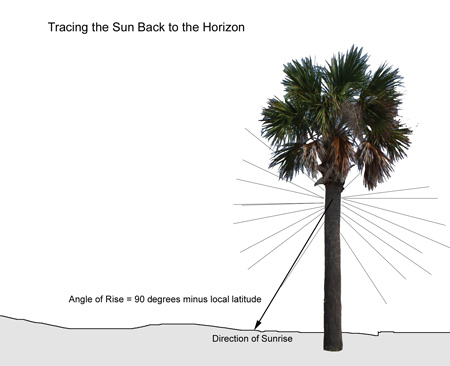
Now, imagine a line from the sun back to the horizon (in the case of sunrise) or forward toward the horizon (in the case of sunset) along an angle of 90 degrees minus your latitude. Where that line touches the earth is about where the sun came up, or about where it will set, as the case may be.
Since you know the direction of sunrise and sunset, you now know the direction of that spot on the horizon, meaning you are now oriented with regard to all directions.
Next, you'll want to find the sun's current bearing. Once this is done, you can use the sun for the next 20 or 30 minutes as your handy celestial guidepost in the sky.
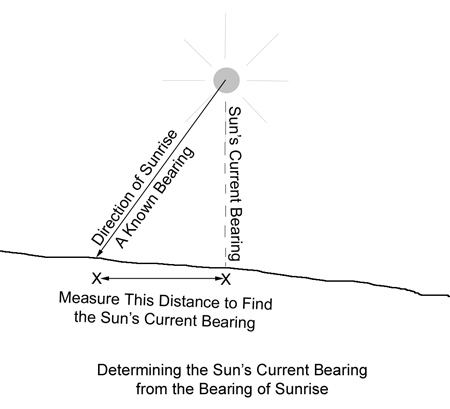
I say 20 or 30 minutes because the sun moves across the sky at 15 degrees per hour, so its directions will be useful only for those few minutes. After that time, you'll need to rework the sun's bearing.
Measuring the distance in degrees of arc from where on the horizon the sun rose (or will set, as the case may be) to the spot on the horizon directly under the sun is easily done with a sextant or some sort of protractor. What's that? You don't have a sextant or a protractor?
No sweat. You can improvise like this:
Extend your arm with the palm of your hand facing away from you, and your four fingers touching one another with your thumb cocked back and pointing upward. The distance between the tip of your thumb and the tip of your index finger will be about 15 degrees. If you find it's less than 15 degrees, just bend your elbow and pull your arm in a bit. It it's more than 15 degrees, extend your arm some. With some trial and error you'll get it right. When you do have it right, six of those measurements (6 turns x 15 degrees = 90 degrees) will take you through a 90-degree (1/4) turn.
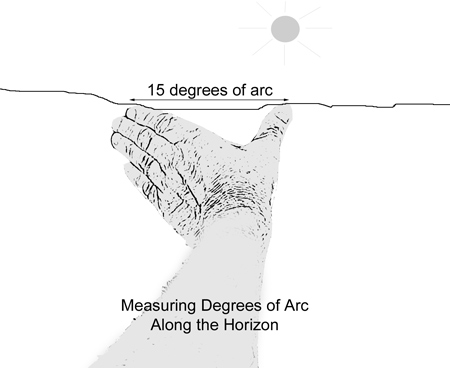
The Sun as Your Guidepost
Now that you know the sun's bearing, you can use the sun as your celestial guidepost to go in any direction you choose. Let's say, for example, the sun bears 135 degrees.
Want to go in the direction of 135 degrees? Great. Just keep the sun dead ahead. Want to go in the exact 180-degree opposite direction, or 315 degrees? Just keep the sun directly behind you. In this case, it will be easier to guide off your shadow. Just keep your shadow dead ahead, and you'll be going in your intended direction.
Knowing in degrees (or compass points) your intended direction of travel, use your "handy" protractor to determine where that particular spot falls on the horizon, or as far as you happen to be able to see. When facing that direction, notice the sun's position. Is it directly to the left of you, over your shoulder, or what? Whatever the sun's position when you face your intended direction of travel, just keep the sun in that position and you'll be going in the intended direction.
Imagine yourself at the center of a great clock--one that has only an hour hand. Wherever you're facing is always 12 o'clock. Notice the sun's position when you're facing your intended direction. If it's at 4 o'clock, keep it there to go where you intend to go. Also, when the sun is at 4 o'clock (or "on your 4" as some say), your shadow will be on the clock's opposite hand, or on your 10. Many times, it may be easier to guide off your shadow than off the sun simply because you can directly look at your shadow, and you can't look at the sun. (See the WARNING above.)
Direction Finding by the Mid-Day Sun
Since tracing the sun to the horizon works best only about three hours after sunrise or three hours before sunset, during the mid-day hours--two hours before and after LAN--you need another way to find directions. At these times you can use a shadow stick.
Shadow Stick
To fashion a shadow stick, poke a fairly straight stick about three feet long into a bit of level ground, preferably in an area of bare ground free of heavy grass, leaves, and other debris that might interfere with what you're trying to do. Your stick doesn't have to be exactly straight or even perpendicular to the ground, but the ground should be level.
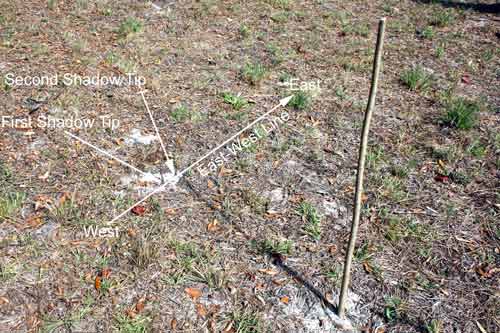
Where the stick's tip casts it shadow, mark that shadow tip with a small stick, pebble, or other such object. If you can't see clearly where the shadow from the stick's tip falls, touch the stick's tip lightly with your finger, watching for where it makes a shadow.
Having marked the shadow made by the stick's tip, wait about 15 minutes for the stick's shadow to move, and once more mark the stick's shadow tip. Be sure that the stick doesn't move once you've begun the process of noting shadow movements.
Since the sun moves to the west, the second shadow tip marking will be to the east of the first, and a line drawn between the two markings will generally be close enough to an east-west line for land-navigation purposes.
The shadow stick method works best around mid-day, all year long. Within a week or so of each equinox, it works all day long, but the rest of the year, as a general rule, use it no more than two hours on either side of LAN.
Shadow stick results are increasingly less accurate as the date moves away from the equinoxes and toward the solstices, especially the winter solstice when the errors are greater than those at the summer solstice.
Considering that any error greater than around 20 degrees is unacceptable, don't use the shadow-stick method more than one hour away from LAN near the winter solstice at latitudes much above 40 degrees. Approaching near 60 degrees latitude and above, don't use it at all near the winter solstice. Away from the equinox at other times in the fall and winter in these high latitudes, use it no more than one hour on either side of LAN.
Having found a reasonable approximation of an east-west line, use it to determine the sun's approximate current bearing. Knowing the sun's current bearing, you can--for the next 20 or 30 minutes--use the sun as a celestial guidepost to help you proceed in any intended direction.
You can get directions by the above method accurate to within 20 degrees, often less. A course within 20 degrees of where you want to go is not as good as a dead accurate course, but it's a lot better than no direction at all. Moreover, if your objective is to find a lengthy baseline only a couple of kilometers or so distant, you can probably tolerate that much inaccuracy in your course.
Direction Finding with the Sun and a Watch
Direction Finding at LAN
If you have a watch, and know the clock time of LAN in your area at your time of year (a good thing to look up before your trip), you already know the sun will cross your meridian at LAN. Except for at certain times in the low latitudes of the tropics, the sun at LAN bears due South in the northern hemisphere, and due North in the Southern hemisphere.
Using the Sun as a Compass
If you have a watch and if the sun's maximum altitude for the day does not exceed 45 degrees, the sun can act as your giant celestial compass.
Let's say you have a watch. Now, if the sun's path across the sky is relatively low--as it will be in winter--the sun's 15-degree-per-hour movement through the sky will more or less coincide with its bearing change. When I say the sun's "bearing," I mean its bearing as projected down to the horizon.
Just because it moves across the sky at 15 degrees per hour, doesn't mean its bearing as projected down to the horizon will necessarily change by a like amount.
For example, on the Equator on either equinox, the sun rises at 90 degrees. Since its rising angle is 90 degrees minus the latitude--zero in this case--the sun will rise at a 90-degree angle. In other words, it will climb straight up. Even though the sun is moving across the sky at 15 degrees per hour, all morning long it bears 90 degrees. At LAN the sun's bearing instantaneously changes by 180 degrees to 270, which it will continue to bear all afternoon until it sets in that direction.
In the above example, the sun's maximum altitude for the day was 90 degrees, meaning at LAN it was straight overhead, or on your "zenith" as they say. When the sun's path across the sky is relatively high, the sun's 15-degree-per-hour movement through the sky does not coincide closely with its hourly bearing change. But when the sun's path across the sky is relatively low to the horizon, the sun's hourly sky movement and its hourly bearing change more or less coincide. What this means to you is with a "low-flying" sun, you can closely relate its hourly bearing change with the hour hand on your watch.
So, how low does the sun have to be? If its maximum altitude for the day does not exceed 45 degrees from the horizon, you're in luck.
But how do you determine the sun's maximum altitude for the day? Easy. Since the sun's maximum altitude occurs at LAN, simply measure the sun's altitude at that time. This isn't precision engineering, so you don't have to hit it exactly at LAN--anytime up to an hour before or after is okay.
What's that? How do you measure the sun's altitude? I knew you were going to ask that. Once again, this is easy...and so logical. You're gonna love this:
Poke a stick in a flat, level section of ground, making the stick as vertical as possible. If the stick's shadow is longer than the stick, the sun's height is less than 45 degrees. If the stick's shadow is shorter than the stick, the sun's height exceeds 45 degrees.
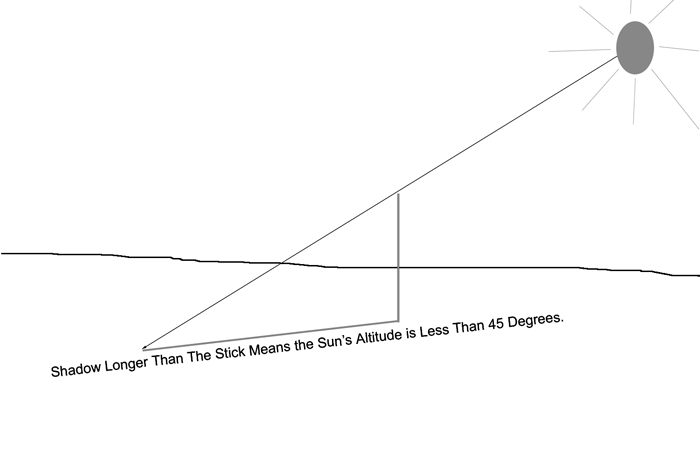
Assuming the sun's maximum altitude for the day is less than about 45 degrees, the sun's bearing as projected down to the horizon will change near enough to 15 degrees per hour so that you can time the bearing changes with your watch.
Since the sun crosses your meridian at LAN, it will bear at that time either 180 degrees in the Northern hemisphere, or 000 degrees in the Southern hemisphere--unless you happen to be in the low latitudes of the tropics. There, the sun could be in the north or the south depending on the time of year.
For each hour removed from LAN, the sun's bearing will change about 15 degrees.
In the Northern Hemisphere, for example, the sun will bear about 165 degrees one hour before LAN, about 150 degrees two hours before LAN, 135 degrees three hours before, and so on. Likewise, in the afternoon, the sun will bear near 195 degrees one hour after LAN, 210 two hours after, 225 three hours after, and so on.
Since you know the time, you can closely approximate the sun's bearing with regard to the hour, regardless of which hemisphere you're in. This system works well all day, except for the very early morning and the very late afternoon. Fortunately, at those times, it makes sense to trace the sun to the horizon to find its bearing.
All Day Directions by the Sun
Direction Finding in the Morning and Afternoon
You now know how to trace both the morning and the afternoon sun back to the horizon to find the direction of sunrise and sunset, the bearing for which you can estimate using the date and the sun's maximum amplitude at your latitude.
Being able to determine the spot where the sun rose, and later in the day, the spot where it will set (using the tracing methods described above), coupled with the ability to estimate the bearing for each of these spots (taking into account the sun's maximum amplitude at your latitude and the date), allows you to use your hand as a makeshift protractor to measure from the known bearing of the sunrise or sunset location to find the sun's current bearing.
Direction Finding at Mid-Day
For mid-day directions, you now know how to use a shadow stick to determine an approximate east-west line to be used to find the sun's current bearing.
You also know that at LAN, the sun bears either due south or due north, depending on your hemisphere. Provided you have an accurate timepiece, and you know the time of LAN, at least you'll know the sun's bearing at that time.
Direction Finding with the Sun and a Watch
What's more, provided that the sun's maximum altitude for the day is no greater than 45 degrees, you know that the sun's bearing away from LAN will change close enough to 15 degrees per hour so that the sun and your timepiece can be used together to determine the sun's bearing all day, with exception to the early morning and late afternoon.
Once you know the sun's current bearing, which you now know how to estimate, you have an effective guidepost to navigate by for at least the next 20 or 30 minutes until the sun changes positions so much that you have to rework the sun's bearing.
Return from Direction Finding by the Sun to Celestial Navigation

